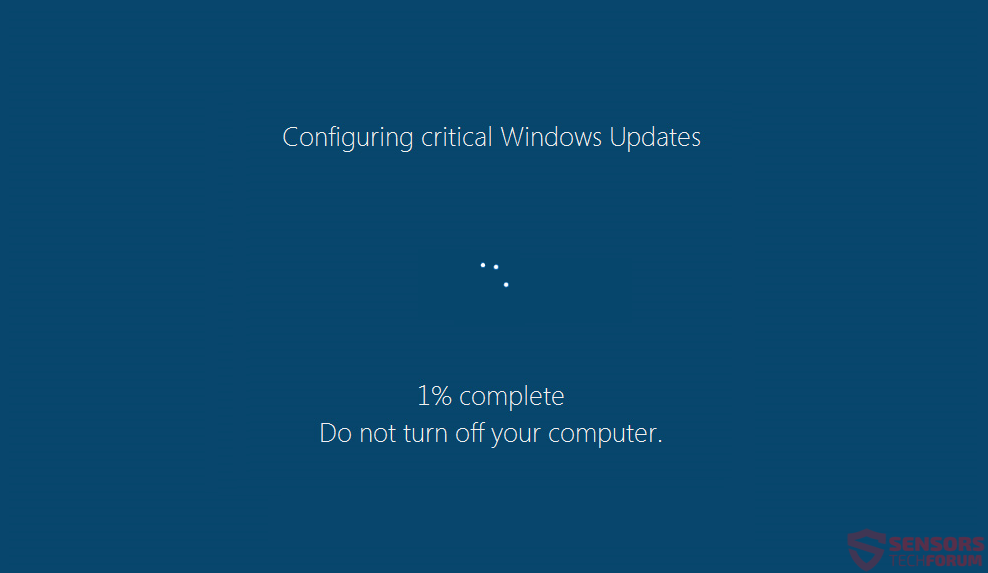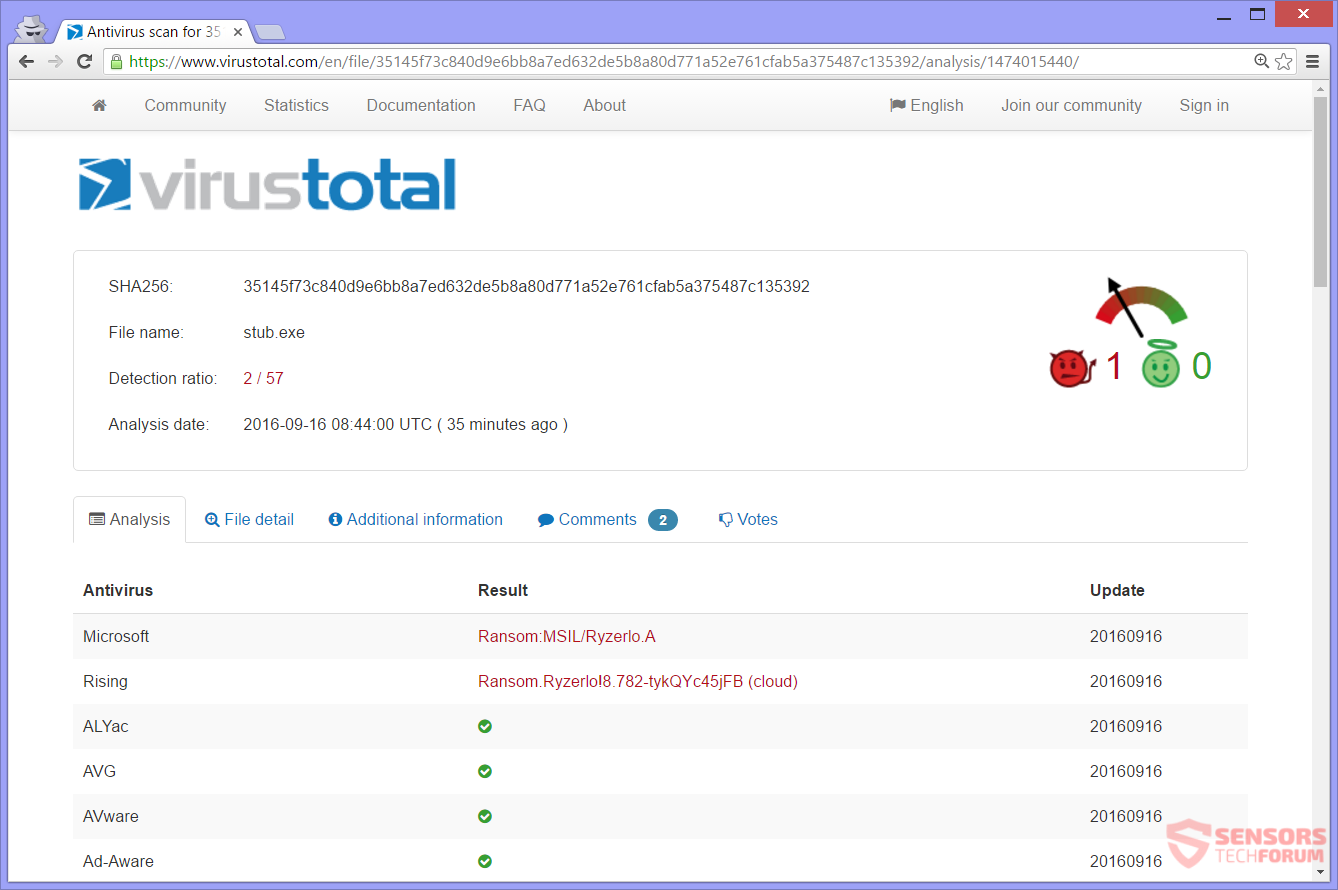A brand new variant of the Fantom crypto-virus is on the loose. The virus has been reported to encrypt files with over 1200 different extensions. Now it appends the extension .locked to the files, ditching the previous .locked extension. Ransom is demanded from victims, and a ProtonMail is given as contact, namely restorefiles@protonmail.ch. To remove the ransomware and see how to try and decrypt some of your data, read the article carefully.

Threat Summary
| Name | Fantom |
| Type | Ransomware, Crypto-Virus |
| Short Description | The ransomware will encrypt your files and demand payment. A ProtonMail address is given as a contact. |
| Symptoms | The ransomware will encrypt over 1200 files with different extensions with the .locked extension appended to them. A ransom note with instructions will be displayed after. |
| Distribution Method | Spam Emails, Email Attachments |
| Detection Tool |
See If Your System Has Been Affected by malware
Download
Malware Removal Tool
|
| User Experience | Join Our Forum to Discuss Fantom. |
| Data Recovery Tool | Windows Data Recovery by Stellar Phoenix Notice! This product scans your drive sectors to recover lost files and it may not recover 100% of the encrypted files, but only few of them, depending on the situation and whether or not you have reformatted your drive. |

Fantom Virus – Infection Spread
The new variant of the Fantom ransomware is possible to spread in several ways. Spam emails are the most probable way to be used in the spreading of the virus. A spam email is usually comprised of a brief description which tries to sound convincing that is of huge importance. Also, victims in most cases fall for the trick of opening an attached file, which supposedly reveals more information or has something useful inside. Those attachment files might look harmless, but upon opening, such a file could drop the payload of the virus and infect your whole PC.
Social media websites or file-sharing networks might be used to further spread this Fantom ransomware variant. The cybercriminals could have put a file containing a malicious script on these networks. Opening the file will release the payload for the ransomware, and your system will get infected. A tip to prevent that from happening is avoiding any suspicious emails, links, and files. When you are about to open a file you just downloaded, check its signatures first, along with its size and scan it with a security program. You can read more ransomware prevention tips in our forum.

Fantom Virus – Technical Description
The Fantom crypto-virus is back with a new variant. The new string of code for the Fantom ransomware was discovered by the malware researchers from the MalwareHunterTeam.
After infection, the payload file will create files on your computer which will launch a fake update. You can view that fake Windows update screen down here:
The screen will be locked and not allow any interaction with it or other windows. If you see that screen, know that your files are in the process of being locked in the background. You might be able to close the screen using the Ctrl + F4 key combination. That will not stop the encryption process from going. The screen even has a percentage counter to fake the spike in activity of your disk drives and best imitate an update.
Next, the Fantom ransomware can create entries in the Windows Registry, which allow it to auto-launch with the start of the Windows Operating System. To support that, the ransomware does not encrypt any files which have the following extensions:
→.sys, .dll, .exe, .ico, .link, .locked, .purge, .frozen, .tmp, .temp, dll, ini, manifest, .com, .prx, .bin, .am, .dlm, .ngr
The following folders will also be ignored and all files inside them will remain unscathed:
→APPDATA, ProgramData, ProgramFiles, WINDOWS, APPDATA, Appdata, Application Data, intel, nvidia, Program Files, Program Files x86, Windows, RECYCLER, Recycle.Bin, Recycler, TEMP, Temp, Microsoft, RECYCLE.BIN
After encrypting the rest of the files set in the ransomware code, a picture with the ransom payment instructions will be placed on your desktop:
The ransom note is changed and looks more professional:
The newly-found Fantom ransomware also does not set a price for paying the ransom, as its previous version. Again it claims to delete your files from its servers after a while – this time the deadline is set to one week. However, the criminals behind it have improved and now use a more secure message system, involving the ProtonMail encrypted e-mail service:
- restorefiles@protonmail.ch
- https://bitmsg.me BM -2cUhQ3orPHtcCKvk2iwCeJnmbSeKLLHdog
Do NOT contact these cyber crooks about decryption. No guarantee there is in the world that you will get your files unlocked and as you can see from this article, they will keep making more ransomware. Giving money to them to unlock your files, and later that money to be used to lock your files again, including those of somebody else, is a viscous circle.
The new version of the Fantom ransomware encrypts an even bigger amount of files compared to its predecessor. The ransomware searches to encrypt files with 1,296 extensions. The list is gigantic, so we put it inside the following drop-down window:
All encrypted files will have the same extension appended to them, which is .locked. The ransomware is believed to use the RSA-2048 encryption algorithm. The public and private keys differ. The private key doesn’t seem to be in the code of the malware sample, according to the MalwareHunterTeam and the ransomware may be deemed not decryptable.
There are not that many detections of the new Fantom variant on VirusTotal:
The Fantom ransomware is highly likely to delete the Shadow Volume Copies from the Windows Operating System. Read down to learn of some ways in which you can try to decrypt some of your files.

Remove Fantom Virus and Restore .locked Files
If your computer got infected with the Fantom ransomware virus, you should have some experience in removing malware. You should get rid of this ransomware as fast as possible before it can have the chance of spreading further and infect more PCs. You should remove the ransomware and follow the step-by-step instructions guide given below. To see ways that you can try to recover your data, see the step titled 2. Restore files encrypted by Fantom.
- Step 1
- Step 2
- Step 3
- Step 4
- Step 5
Step 1: Scan for Fantom with SpyHunter Anti-Malware Tool



Ransomware Automatic Removal - Video Guide
Step 2: Uninstall Fantom and related malware from Windows
Here is a method in few easy steps that should be able to uninstall most programs. No matter if you are using Windows 10, 8, 7, Vista or XP, those steps will get the job done. Dragging the program or its folder to the recycle bin can be a very bad decision. If you do that, bits and pieces of the program are left behind, and that can lead to unstable work of your PC, errors with the file type associations and other unpleasant activities. The proper way to get a program off your computer is to Uninstall it. To do that:


 Follow the instructions above and you will successfully delete most unwanted and malicious programs.
Follow the instructions above and you will successfully delete most unwanted and malicious programs.
Step 3: Clean any registries, created by Fantom on your computer.
The usually targeted registries of Windows machines are the following:
- HKEY_LOCAL_MACHINE\Software\Microsoft\Windows\CurrentVersion\Run
- HKEY_CURRENT_USER\Software\Microsoft\Windows\CurrentVersion\Run
- HKEY_LOCAL_MACHINE\Software\Microsoft\Windows\CurrentVersion\RunOnce
- HKEY_CURRENT_USER\Software\Microsoft\Windows\CurrentVersion\RunOnce
You can access them by opening the Windows registry editor and deleting any values, created by Fantom there. This can happen by following the steps underneath:


 Tip: To find a virus-created value, you can right-click on it and click "Modify" to see which file it is set to run. If this is the virus file location, remove the value.
Tip: To find a virus-created value, you can right-click on it and click "Modify" to see which file it is set to run. If this is the virus file location, remove the value.
Before starting "Step 4", please boot back into Normal mode, in case you are currently in Safe Mode.
This will enable you to install and use SpyHunter 5 successfully.
Step 4: Boot Your PC In Safe Mode to isolate and remove Fantom





Step 5: Try to Restore Files Encrypted by Fantom.
Method 1: Use STOP Decrypter by Emsisoft.
Not all variants of this ransomware can be decrypted for free, but we have added the decryptor used by researchers that is often updated with the variants which become eventually decrypted. You can try and decrypt your files using the instructions below, but if they do not work, then unfortunately your variant of the ransomware virus is not decryptable.
Follow the instructions below to use the Emsisoft decrypter and decrypt your files for free. You can download the Emsisoft decryption tool linked here and then follow the steps provided below:
1 Right-click on the decrypter and click on Run as Administrator as shown below:

2. Agree with the license terms:

3. Click on "Add Folder" and then add the folders where you want files decrypted as shown underneath:

4. Click on "Decrypt" and wait for your files to be decoded.

Note: Credit for the decryptor goes to Emsisoft researchers who have made the breakthrough with this virus.
Method 2: Use data recovery software
Ransomware infections and Fantom aim to encrypt your files using an encryption algorithm which may be very difficult to decrypt. This is why we have suggested a data recovery method that may help you go around direct decryption and try to restore your files. Bear in mind that this method may not be 100% effective but may also help you a little or a lot in different situations.
Simply click on the link and on the website menus on the top, choose Data Recovery - Data Recovery Wizard for Windows or Mac (depending on your OS), and then download and run the tool.
Fantom-FAQ
What is Fantom Ransomware?
Fantom is a ransomware infection - the malicious software that enters your computer silently and blocks either access to the computer itself or encrypt your files.
Many ransomware viruses use sophisticated encryption algorithms to make your files inaccessible. The goal of ransomware infections is to demand that you pay a ransom payment to get access to your files back.
What Does Fantom Ransomware Do?
Ransomware in general is a malicious software that is designed to block access to your computer or files until a ransom is paid.
Ransomware viruses can also damage your system, corrupt data and delete files, resulting in the permanent loss of important files.
How Does Fantom Infect?
Via several ways.Fantom Ransomware infects computers by being sent via phishing emails, containing virus attachment. This attachment is usually masked as an important document, like an invoice, bank document or even a plane ticket and it looks very convincing to users.
Another way you may become a victim of Fantom is if you download a fake installer, crack or patch from a low reputation website or if you click on a virus link. Many users report getting a ransomware infection by downloading torrents.
How to Open .Fantom files?
You can't without a decryptor. At this point, the .Fantom files are encrypted. You can only open them once they are decrypted using a specific decryption key for the particular algorithm.
What to Do If a Decryptor Does Not Work?
Do not panic, and backup the files. If a decryptor did not decrypt your .Fantom files successfully, then do not despair, because this virus is still new.
Can I Restore ".Fantom" Files?
Yes, sometimes files can be restored. We have suggested several file recovery methods that could work if you want to restore .Fantom files.
These methods are in no way 100% guaranteed that you will be able to get your files back. But if you have a backup, your chances of success are much greater.
How To Get Rid of Fantom Virus?
The safest way and the most efficient one for the removal of this ransomware infection is the use a professional anti-malware program.
It will scan for and locate Fantom ransomware and then remove it without causing any additional harm to your important .Fantom files.
Can I Report Ransomware to Authorities?
In case your computer got infected with a ransomware infection, you can report it to the local Police departments. It can help authorities worldwide track and determine the perpetrators behind the virus that has infected your computer.
Below, we have prepared a list with government websites, where you can file a report in case you are a victim of a cybercrime:
Cyber-security authorities, responsible for handling ransomware attack reports in different regions all over the world:
Germany - Offizielles Portal der deutschen Polizei
United States - IC3 Internet Crime Complaint Centre
United Kingdom - Action Fraud Police
France - Ministère de l'Intérieur
Italy - Polizia Di Stato
Spain - Policía Nacional
Netherlands - Politie
Poland - Policja
Portugal - Polícia Judiciária
Greece - Cyber Crime Unit (Hellenic Police)
India - Mumbai Police - CyberCrime Investigation Cell
Australia - Australian High Tech Crime Center
Reports may be responded to in different timeframes, depending on your local authorities.
Can You Stop Ransomware from Encrypting Your Files?
Yes, you can prevent ransomware. The best way to do this is to ensure your computer system is updated with the latest security patches, use a reputable anti-malware program and firewall, backup your important files frequently, and avoid clicking on malicious links or downloading unknown files.
Can Fantom Ransomware Steal Your Data?
Yes, in most cases ransomware will steal your information. It is a form of malware that steals data from a user's computer, encrypts it, and then demands a ransom in order to decrypt it.
In many cases, the malware authors or attackers will threaten to delete the data or publish it online unless the ransom is paid.
Can Ransomware Infect WiFi?
Yes, ransomware can infect WiFi networks, as malicious actors can use it to gain control of the network, steal confidential data, and lock out users. If a ransomware attack is successful, it could lead to a loss of service and/or data, and in some cases, financial losses.
Should I Pay Ransomware?
No, you should not pay ransomware extortionists. Paying them only encourages criminals and does not guarantee that the files or data will be restored. The better approach is to have a secure backup of important data and be vigilant about security in the first place.
What Happens If I Don't Pay Ransom?
If you don't pay the ransom, the hackers may still have access to your computer, data, or files and may continue to threaten to expose or delete them, or even use them to commit cybercrimes. In some cases, they may even continue to demand additional ransom payments.
Can a Ransomware Attack Be Detected?
Yes, ransomware can be detected. Anti-malware software and other advanced security tools can detect ransomware and alert the user when it is present on a machine.
It is important to stay up-to-date on the latest security measures and to keep security software updated to ensure ransomware can be detected and prevented.
Do Ransomware Criminals Get Caught?
Yes, ransomware criminals do get caught. Law enforcement agencies, such as the FBI, Interpol and others have been successful in tracking down and prosecuting ransomware criminals in the US and other countries. As ransomware threats continue to increase, so does the enforcement activity.
About the Fantom Research
The content we publish on SensorsTechForum.com, this Fantom how-to removal guide included, is the outcome of extensive research, hard work and our team’s devotion to help you remove the specific malware and restore your encrypted files.
How did we conduct the research on this ransomware?
Our research is based on an independent investigation. We are in contact with independent security researchers, and as such, we receive daily updates on the latest malware and ransomware definitions.
Furthermore, the research behind the Fantom ransomware threat is backed with VirusTotal and the NoMoreRansom project.
To better understand the ransomware threat, please refer to the following articles which provide knowledgeable details.
As a site that has been dedicated to providing free removal instructions for ransomware and malware since 2014, SensorsTechForum’s recommendation is to only pay attention to trustworthy sources.
How to recognize trustworthy sources:
- Always check "About Us" web page.
- Profile of the content creator.
- Make sure that real people are behind the site and not fake names and profiles.
- Verify Facebook, LinkedIn and Twitter personal profiles.






